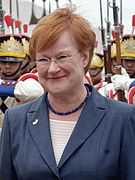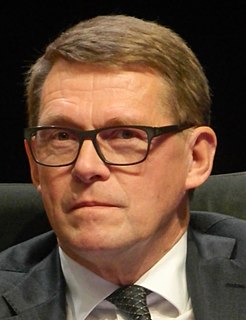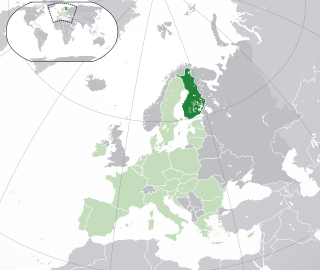| |||||||||||||||||
| |||||||||||||||||
| |||||||||||||||||
 |
|---|
| This article is part of a series on the politics and government of Finland |
Executive
|
Legislative
|


A presidential election was held in Finland on 15 and 29 January 2006 which resulted in the re-election of Tarja Halonen as President of Finland for a second six-year term.

Finland, officially the Republic of Finland is a country in Northern Europe bordering the Baltic Sea, Gulf of Bothnia, and Gulf of Finland, between Norway to the north, Sweden to the northwest, and Russia to the east. Finland is a Nordic country and is situated in the geographical region of Fennoscandia. The capital and largest city is Helsinki. Other major cities are Espoo, Vantaa, Tampere, Oulu and Turku.

Tarja Kaarina Halonen is a Finnish politician who served as the 11th President of Finland, and the first woman to hold the position, from 2000 to 2012. She first rose to prominence as a lawyer with the Central Organisation of Finnish Trade Unions (SAK), and as the Prime Minister's parliamentary secretary (1974-1975) and a member of the City Council of Helsinki (1977-1996). Halonen was a Social Democratic Party member of parliament from 1979 until her election to the presidency in 2000. She also served as a minister at the Ministry of Social Affairs and Health from 1987 to 1990, as Minister of Justice from 1990 to 1991, and as Minister for Foreign Affairs from 1995 to 2000.

The President of the Republic of Finland is the head of state of Finland. Under the Constitution of Finland, executive power is vested in the President and the Finnish Government, with the former possessing only residual powers. The President is directly elected by universal suffrage for a term of six years. Since 1991, no President may be elected for more than two consecutive terms. The President must be a Finnish citizen by birth. The Presidential office was established in the Constitution Act of 1919. Since March 1, 2012, the President of Finland has been Sauli Niinistö. In May 2017, Niinistö announced that he would seek re-election in the 2018 presidential election, running as an independent candidate. NCP and the Christian Democrat Party supported his candidacy. He won re-election in the first round on 28 January 2018 with 62.7% of the vote and his second term began on 1 February 2018.
Contents
The first round of voting in Finnish presidential elections always takes place on the third Sunday of January, in this case 15 January 2006. As no candidate received more than half of the vote, a second round was held on 29 January between the two highest placed candidates from the first round, Tarja Halonen and Sauli Niinistö. Tarja Halonen, the incumbent, won the final round by 3.6 percentage points. The newly elected president formally took office for her second term on 1 March, and would have done so on 1 February, had no run-off been necessary (Constitution 55 §).

Voting is a method for a group, such as a meeting or an electorate, in order to make a collective decision or express an opinion, usually following discussions, debates or election campaigns. Democracies elect holders of high office by voting. Residents of a place represented by an elected official are called "constituents", and those constituents who cast a ballot for their chosen candidate are called "voters". There are different systems for collecting votes.

Sauli Väinämö Niinistö is a Finnish politician and the 12th President of Finland, in office since 2012.
Advance voting is possible in Finnish elections, and the dates for this in the first round were the 4th, 5th and 7th to 10 January. Finnish citizens voting abroad could vote from the 4th to the 7th of January. An advantage to advance voting is that those doing so have a wider choice of polling stations (typically post offices, such as the one shown here), whereas on the actual election day the polling stations are fixed, usually schools, libraries or town halls.
























